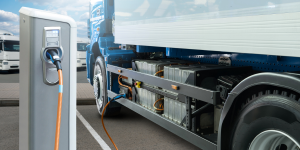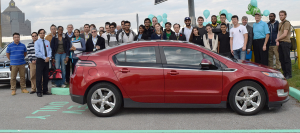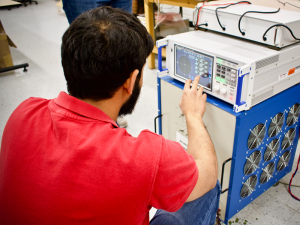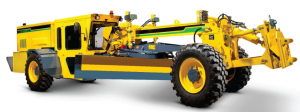The national mandate to have all new light-duty vehicles sold in Canada be zero-emission by 2035 is ambitious, controversial, perhaps even over-reaching.
But it is also creating many new opportunities for Canadian technology students, for workers already in the auto industry, as well as for the general public to study, learn and work with zero-emission vehicles, ZEVS, of all types – from cars for the consumer market to heavy-duty vehicles for industry.
For some students, learning means building their own functional ZEV model.

ZEVS of all types – zero-emission cars for the consumer market to heavy-duty trucks for industry – make new learning and training programs more necessary.
ZEVs, including fully battery-electric, plug-in hybrid electric, and hydrogen fuel cell electric vehicles, are gaining popularity in Canada: in 2017, there were less than 50,000 ZEVs on the country’s roadways. Last year, that number passed 500,000, as nearly 185,000 new electric vehicles were registered (that’s a big increase from the previous year, although it represents just 11 per cent of all new motor vehicles registered that year).
Understanding the overall goals of a zero-emission vehicle policy, recognizing the infrastructure needs of a truly zero-emission transportation sector, training the next generation of repair and maintenance technicians for all those new vehicles registered are key components of a successful and beneficial ZEV program.
So, new training, education, and awareness courses are launching across the country, including free online programs for the general public, part-time programs to upgrade technicians who need to learn about electric vehicles, hands-on research and development of zero-emission infrastructure, as well as for young people in secondary or post-secondary education who are looking to take advantage of a new career in a new sector.
In British Columbia, for example, faculty experts from BCIT Applied Research and the BCIT School of Transportation have created four free open and online learning courses that aim to build awareness and public confidence in electric vehicle ownership, particularly in underrepresented communities (the course is open to all).

Courses designed to build awareness and public confidence in electric vehicle ownership are offered free of charge.
Funded by a grant from Natural Resources Canada, the Fueling Change project informs participants about emerging charger technology, future battery development trends, autonomous charging and other important aspects of hydrogen energy development.
Industry partners and members of the community, including people with disabilities, Indigenous persons, youth, and seniors with age-related mobility challenges were also involved in developing the content for this EV awareness program for the general public (additional courses are available).
Then there are several new part-time courses being offered across the country for folks already working in the automotive sector, for example, who need or want to upgrade their abilities as service technicians to be able to work on new electric vehicles.

Students at Centennial College benefit from hands-on learning about what makes ZEVs (zero-emission vehicles) vehicles.
At Centennial College in Toronto, as just one example, course development for the Hybrid and Electric Vehicle Certification Program was undertaken to help independent auto mechanics and service fleet techs who may need – will need at some point– to service electric vehicles.
Enrollees benefit from hands-on learning about what makes these new vehicles run, as Centennial recently acquired a Chevrolet BOLT plug-in EV, a Ford Lightning Pickup, and two plug-in Toyota Hybrid Prius vehicles which students work on in-class, in addition to various other donated EVs.
Meanwhile, education and research initiatives like those at the University of Toronto look not only at electronic vehicles, but the infrastructure they need and the spin-offs they might generate.

Education and research initiatives like those at the University of Toronto look not only at electronic vehicles, but the infrastructure they need and the spin-offs they might generate.
Students at the U of T’s Electric Vehicle Research Centre see the electrification of vehicles as a major step in modernization, one which will not only reduce emissions from but expand the utility of EVs overall.
There are new uses for evehicles being researched, including their ability to be a mobile or stationary charger that provides power to the grid in support of powering homes (or other electric vehicles). Vehicle electrification can also be seen as a development platform for electrical, computer, mechanical, industrial and aerospace engineering researchers working to improve autonomous vehicle performance and driver/passenger/pedestrian safety.
Most recently, the Innovation Centre for Advanced Manufacturing and Prototyping (ICAMP) at Canadore College opened its doors to more than 100 secondary school students from Nipissing, Parry Sound, and West Nipissing, so they could learn about evehicles, sustainable energy, and critical mineral extraction/processing sectors.
Canadore College is expanding its Motive Power programs to include battery electric technology, and it has opened a new Zero Emission Training Centre at its Commerce Court campus.
Canadore currently delivers training in motive power programs using conventional internal combustion engines, but the new training centre provide students with access to targeted technologies like electric vehicles, battery electric recreational vehicles, and yard tools.

Secondary School Students visit Canadore College in North Bay, Ontario to learn more about evehicles, sustainable energy, and critical minerals, and the potential careers in those sectors. (CNW Group/Canadore College)
As part of their learning experience, students discussed what is required in a functional eVehicle as they assembled a functional eVehicle model. The program shows students possible career paths in the growing electric vehicle sector, helping them better understand opportunities in STEM (science, technology, engineering, and math) fields as well as the skilled trades.
Careers in electric vehicles are rapidly expanding as the world shifts towards sustainable energy solutions, students heard. By exploring cutting-edge EV technologies during the workshop, they gained valuable insights about a field where STEM knowledge and skilled trade expertise can open many doors.
Their learning included workshops on critical minerals, EV battery materials and testing, and sessions in Canadore’s Motive Power Zero Emission Training Centre. The training was conducted by automotive, electrical, and innovation experts at Canadore College, from ICAMP, and from Miller Technology, a North Bay, ON-based company that is now developing advanced technologies for modern mining operations.
That put the students in direct contact with a global leader in the industry, a company known for putting electric and battery utility vehicles in mines worldwide.
The company has developed a conversion kit to change a diesel engine for an electric motor, for example, and its huge eGrader low-profile grading machine (low-profile graders are used in underground mining where the height of the mine shaft is not enough to accommodate conventional graders. Historically these graders were run by diesel engines, which emit greenhouse gasses that severely limit underground air quality).

An Ontario company has developed a conversion kit to change a diesel engine for an electric motor, for example, in huge graders used in modern mining. The company also advised on EV courses for Ontario college students.
Miller’s E-Grader was built by retrofitting an HBM-Novas 110-M low profile grader with Miller’s patented IONIC Drive system (an advanced form of electric propulsion some might associate with spacecraft propulsion but is very much in use here on Earth). The 24-ft long machine, equipped with plowing blades, grinding wheels and more, can travel up to 33 km per hour when required, either above or below ground.
As the province and the country moves to electrification in automotive and mobility activities, current and future generations of workers are needed.

Zero-emission vehicle workshops, including critical minerals, EV battery materials and testing, were conducted at Canadore’s Motive Power Zero Emission Training Centre. (CNW Group/Canadore College)
What George Burton, Canadore President and CEO, said on the expansion his school’s EV program can and is being applied at many similar education institutions and training facilities across the country.
“Canadore will play a critical role in filling the growing workforce demands and opportunities within Ontario’s critical minerals, electrical vehicles, and advanced manufacturing sectors. These students now know what Canadore can offer them in terms of career preparation.”
And what opportunities lie ahead in Canada’s evolving automotive and mobility industries.
-30-



